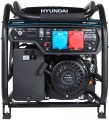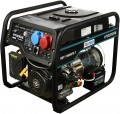Add to comparison |  |  |
|---|---|---|
| Hyundai HHY10050FE-T | Hyundai HHY10000FE-T | |
| Outdated Product | Outdated Product | |
| TOP sellers | ||
Company engine. Electric starter. Automatic voltage regulator (AVR). Socket 400 V. Output 12 V. HHY10050FE without auto start (230 V), HHY10050FE ATS with auto start (230 V), HHY10050FE-T without auto start (400 V), HHY10050FE-3 ATS with auto start (400 V) | HHY10000FE without auto start (230 V), HHY10000FE ATS with auto start (230 V), HHY10000FE-T without auto start (400 V), HHY10000FE-3 ATS with auto start (400 V) | |
| Fuel | petrol | petrol |
| Output voltage | 230 and 400 V | 230 and 400 V |
| Rated power | 7.5 kW | 7.5 kW |
| Max. power | 8 kW | 8 kW |
| Alternator | synchronous | synchronous |
| Alternator winding | copper | copper |
Engine | ||
| ICE type | 4-stroke | 4-stroke |
| Motor type | Hyundai IC460 | Hyundai IC460 |
| Engine size | 460 cm³ | 460 cm³ |
| Power | 17 hp | 18 hp |
| Starter type | electric starter (key) | electric starter (key) |
| Fuel consumption (50% load) | 1.78 l/h | |
| Fuel tank volume | 25 L | 25 L |
| Fuel level indicator | ||
| Motor cooling | air | air |
Connection (sockets) | ||
| Total number of sockets | 2 | 2 |
| Sockets 230 V | 32 A x1 | 32 A x1 |
| Sockets 400 V | 32 A x1 | 32 A x1 |
| Output 12 V | terminals | terminals |
Features | ||
| Features | automatic voltage regulator (AVR) display hour metre voltmeter | automatic voltage regulator (AVR) display hour metre voltmeter |
General | ||
| Protection level | IP 23 | IP 23 |
| Noise level | 74 dB | 74 dB |
| Dimensions | 725х595х580 mm | 750x590x620 mm |
| Weight | 99 kg | 89.5 kg |
| Added to E-Catalog | january 2020 | july 2018 |